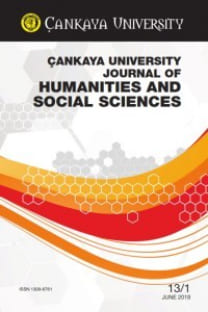Julian Barnes’ ın Korkulacak Bir Şey Yok Adlı Eserinde Ölüm ve Ölüm Korkusu
Ölüm, ölüm korkusu, korku yönetimi kuramı, Julian Barnes, Korkulacak Bir Şey Yok
The Portrayal of Death and the Fear of Death in Julian Barnes’ Nothing to be Frightened Of
Death, fear of death, terror-management theory, Julian Barnes, Nothing to be Frightened Of,
___
- Barnes, Julian. Nothing to be Frightened Of. Alfred A Knopf, 2008.
- Callus, Ivan. “There is great unrest: Some Reflections on Emotion ad Memory in Julian Barnes’ Nothing to be frightened Of and The Sense of an Ending.” Prague Journal of English Studies, 1.1, 2012, pp. 55-64.
- Gholami, Soudabe. “Resistance to the Discourse of Death in Nothing to be Frightened Of by Julian Barnes in the light of Michael Foucault.” CS Canada, Studies in Literature and Language, Vol. 3, No. 2, 2011, pp. 123-128.
- Guignery, Vanessa and Roberts, Ryan (eds). “Interview with Julian Barnes.” Conversations with Julian Barnes. University Press of Mississippi, 2009.
- Kermode, Frank. The Sense of An Ending: Studies in the Theory of Fiction with a New Epilogue. Oxford University Press, 2000.
- Lopez-Deflory, Estefania. “Beginnings, Middles, and Ends: A Kermodian Reading of Julian Barnes’s Nothing to be Frightened Of and The Sense of an Ending.” English: Journal of English Association, Vol. 65, Summer 2016, pp. 158-173.
- Oré-Piqueras, Maricel. “Exploring the Path to Death Through Barnes’s Older Characters: Between Irony and Melancholic Meditation.” Aging Studies, 44.15, 2017, pp. 15-21.
- Renard, Jules, The Journal of Jules Renard (translated and edited by Louise Bogan, Elisabeth Roget). George Braziller, 1964.
- Solomon, Sheldon, Jeff Greenberg and Tom Pyszczynski. The Worm at the Core: On the Role of Death in Life. Random House, 2015.
- Teske, Joanna Klara. “Nothing to be Frightened Of”: Julian Barnes’ Meditation on Death.” (Non)omnis moriar: Cultural and Literary Discourses of Death and Immortality. UMCS, 2012. pp. 225-232.
- ISSN: 1309-6761
- Yayın Aralığı: Yılda 2 Sayı
- Başlangıç: 2004
- Yayıncı: Çankaya Üniversitesi
Edebiyat Kuramı, Biçimbilim ve Bilişsel Şiirbilim
Julian Barnes’ ın Korkulacak Bir Şey Yok Adlı Eserinde Ölüm ve Ölüm Korkusu
Bilişsel Sözlük Bilim: İngilizce Devinim Fiillerinin Yeniden Düşünülmesi
Flaubert’in Papağanı Romanında Yazar, Otorite ve Özgünlük Arayışı
Mustafa Zeki ÇIRAKLI, Öznur YEMEZ
Yas Kefenini Sökmek: Don DeLillo’nun The Body Artist Adlı Romanı
Mantığa Aykırı Bir Normalliğin Peşinde Amansız Bir Arayış: Sally Rooney’nin Normal People Romanı
Thackeray’in Çocukları: Gülme, Çocukluk ve Peri Masalının Büyü Bozumuna Uğratılışı
